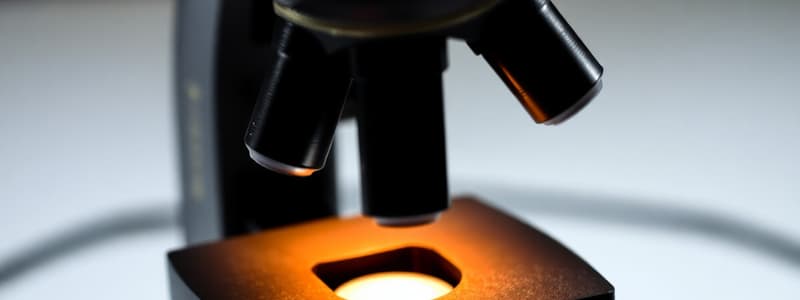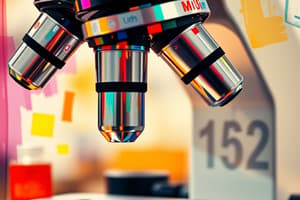Podcast
Questions and Answers
The ______ is a small cylinder attached to the upper part of the body tube that holds the ocular lens.
The ______ is a small cylinder attached to the upper part of the body tube that holds the ocular lens.
Mechanical Draw tube
The ______ connects the ocular lens to the revolving nosepiece.
The ______ connects the ocular lens to the revolving nosepiece.
Body tube
The ______ is an adjustable knob that moves either the body tube or stage upward or downward in greater increments.
The ______ is an adjustable knob that moves either the body tube or stage upward or downward in greater increments.
Coarse adjustment knob
The ______ provides firm and steady support to the entire microscope.
The ______ provides firm and steady support to the entire microscope.
The ______ regulates how much light passes through the specimen.
The ______ regulates how much light passes through the specimen.
The ______ is used to secure the specimen slide on the stage.
The ______ is used to secure the specimen slide on the stage.
The ______ reflects light and directs it to the specimen slide.
The ______ reflects light and directs it to the specimen slide.
The ______ is used to magnify the specimen under study and can come in three types.
The ______ is used to magnify the specimen under study and can come in three types.
The ______ supports the body tube and is used to carry the microscope.
The ______ supports the body tube and is used to carry the microscope.
The ______ is a platform where the specimen slide is placed.
The ______ is a platform where the specimen slide is placed.
The ______ concentrates light onto the specimen and is located above the iris diaphragm.
The ______ concentrates light onto the specimen and is located above the iris diaphragm.
The ______ is an adjustable knob that brings the specimen into sharp focus using lesser increments.
The ______ is an adjustable knob that brings the specimen into sharp focus using lesser increments.
The ______ must be used only with the scanner or low power objective.
The ______ must be used only with the scanner or low power objective.
The ______ is a circular part that holds the objectives and allows for their rotation.
The ______ is a circular part that holds the objectives and allows for their rotation.
The ______ provides support above the base and is crucial for the microscope's structure.
The ______ provides support above the base and is crucial for the microscope's structure.
The ______ has knobs to adjust its position and is vital for concentrating light.
The ______ has knobs to adjust its position and is vital for concentrating light.
The ______ is a detachable cylinder used to view the specimen and can magnify objects up to 10x.
The ______ is a detachable cylinder used to view the specimen and can magnify objects up to 10x.
The ______ is used to regulate light passing through the specimen and is controlled by a lever.
The ______ is used to regulate light passing through the specimen and is controlled by a lever.
Flashcards are hidden until you start studying
Study Notes
Mechanical Parts of a Compound Light Microscope
- Draw tube: Located at the top of the body tube, the draw tube securely holds the ocular lens.
- Body tube: The body tube connects the ocular lens to the revolving nosepiece.
- Coarse adjustment knob: This knob moves the body tube or stage significantly for initial specimen focusing. It's primarily used with the scanner or low-power objective.
- Fine adjustment knob: This knob provides precise movement of the body tube or stage for sharper focusing, mainly used with high-power and oil immersion objectives.
- Arm: Supporting the body tube, the arm is also used for carrying the microscope.
- Revolving nosepiece: This circular and revolving part holds the objective lenses and is connected to the body tube.
- Stage: The stage is a platform where the specimen slide is placed. It features a central hole for light to pass through the specimen.
- Stage clips: Stage clips secure the specimen slide in place on the stage.
- Inclination joint: Attached to the pillar, the inclination joint allows tilting the microscope.
- Pillar: The pillar provides support above the base and connects to the arm.
- Base: The base forms the foundation of the microscope, providing stable support for the whole instrument.
Optical Parts of a Compound Light Microscope
-
Ocular lens (Eyepiece): The detachable ocular lens, positioned at the top of the draw tube, magnifies the specimen. Typically, it provides a 10x magnification. Some ocular lenses feature a black line as a pointer.
-
Objective lenses: Multiple objective lenses with varying magnifications are used to magnify the specimen. A standard compound microscope usually has three objective lenses: low-power objective (LPO), high-power objective (HPO), and oil immersion objective (OIO). Some microscopes may include an additional scanner objective, which sometimes replaces the OIO. The order in which objective lenses are used: scanner (if present), LPO, HPO, and OIO.
-
Illuminating Condenser: Located above the iris diaphragm, the illuminating condenser concentrates light onto the specimen. It might have knobs for adjusting its position.
-
Iris diaphragm: The iris diaphragm regulates the intensity of light that passes through the specimen. A lever controls the diaphragm, allowing the amount of light to be adjusted.
-
Mirror: Positioned beneath the stage, near the base, the mirror reflects light toward the specimen slide. The reflected image is then directed back to the observer's eyes.
-
Key Points*
-
The table illustrates the parts of a compound light microscope and their functions.
-
The microscope consists of mechanical parts that provide framework and support, and optical parts that manage light and image formation.
-
The table also highlights the order of using objective lenses and the purpose of each lens.
-
The function of each part contributes to the overall process of viewing and studying specimens under the microscope.
Compound Light Microscope Parts and Functions
- Mechanical Draw Tube: A small cylinder attached to the body tube, holding the ocular lens.
- Body Tube: Connects the ocular lens to the revolving nosepiece.
- Coarse Adjustment Knob: Moves the body tube or stage in large increments for initial focusing, primarily used with the scanner or low-power objective.
- Fine Adjustment Knob: Moves the body tube or stage in smaller increments for sharp focusing, best used with high-power or oil immersion objectives.
- Arm: Supports the body tube and serves as the carrying handle for the microscope.
- Revolving Nosepiece: Circular and revolving part connected to the body tube, holding the objective lenses.
- Stage: Platform where the specimen slide is placed, featuring a central hole allowing light to pass through the specimen.
- Stage Clips: Secure the specimen slide on the stage.
- Inclination Joint: Attaches the arm to the pillar, enabling tilting of the microscope.
- Pillar: Provides support above the base, connecting to the arm.
- Base: Provides a stable foundation for the entire microscope.
- Magnifying Ocular Lens or Eyepiece: Detachable cylinder at the top of the draw tube, used for viewing the specimen, typically magnifying up to 10x. Some have a pointer for reference.
- Objective Lens: Magnifies the specimen, usually consisting of low-power (LPO), high-power (HPO), and oil immersion (OIO) lenses. Some microscopes may include a scanner objective.
- Illuminating Condenser: Concentrates light onto the specimen, located above the iris diaphragm, with adjustable knobs for positioning.
- Iris Diaphragm: Controls light passing through the specimen, using a lever to adjust the amount of light.
- Mirror: Found below the stage, near the base, it reflects light towards the specimen slide and back to the eye.
Studying That Suits You
Use AI to generate personalized quizzes and flashcards to suit your learning preferences.




